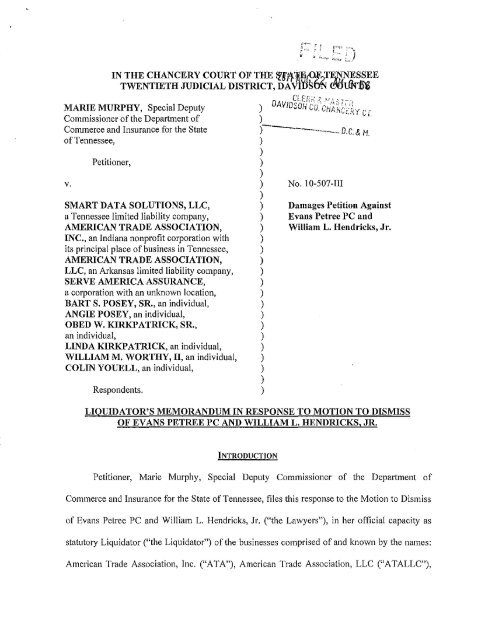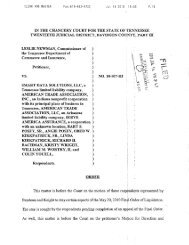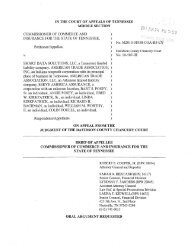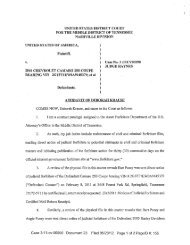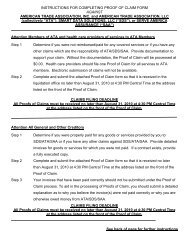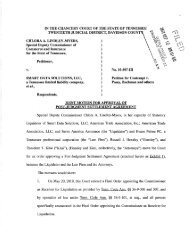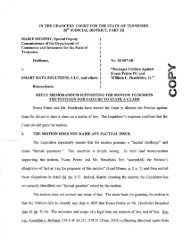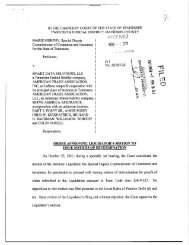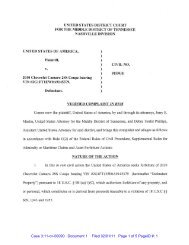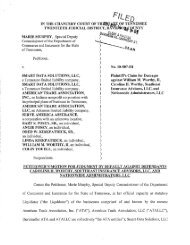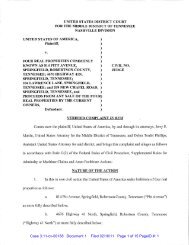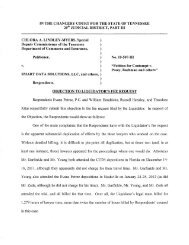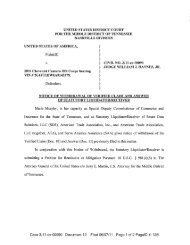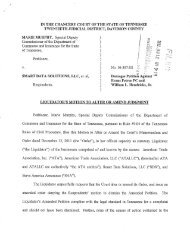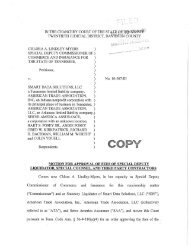IN THE CHANCERY COURT OF THE - here
IN THE CHANCERY COURT OF THE - here
IN THE CHANCERY COURT OF THE - here
You also want an ePaper? Increase the reach of your titles
YUMPU automatically turns print PDFs into web optimized ePapers that Google loves.
<strong>IN</strong> <strong>THE</strong> <strong>CHANCERY</strong> <strong>COURT</strong> <strong>OF</strong> <strong>THE</strong> !U;}1If-'l(O;!/;}~.NESSEE<br />
TWENTIETH JUDICIAL DISTRICT, DA Vi:'i:JSUN ~ukfY6<br />
MARIE MURPHY, Special Deputy<br />
Commissioner of the Department of<br />
Commerce and Insurance for the State<br />
of Tennessee,<br />
Petitioner,<br />
v.<br />
SMART DATA SOLUTIONS, LLC,<br />
a Tennessee limited liability company,<br />
AMERICAN TRADE ASSOCIATION,<br />
<strong>IN</strong>C., an Indiana nonprofit corporation with<br />
its principal place of business in Tennessee,<br />
AMERICAN TRADE ASSOCIATION,<br />
LLC, an Arkansas limited liability company,<br />
SERVE AMERICA ASSURANCE,<br />
a corporation with an unknown location,<br />
BARTS. POSEY, SR., an individual,<br />
ANGIE POSEY, an individual,<br />
OBED W. KIRKPATRICK, SR.,<br />
an individual,<br />
L<strong>IN</strong>DA KIRKPATRICK, an individual,<br />
WILLIAM M. WORTHY, II, an individual,<br />
COL<strong>IN</strong> YOUELL, an individual,<br />
No. I 0-507-III<br />
Damages Petition Against<br />
Evans Petree PC and<br />
William L. Hendricks, Jr.<br />
Respondents.<br />
LIOUIDATOR'S MEMORANDUM <strong>IN</strong> RESPONSE TO MOTION TO DISMISS<br />
<strong>OF</strong> EVANS PETREE PC AND WILLIAM L. HENDRICKS, JR.<br />
<strong>IN</strong>TRODUCTION<br />
Petitioner, Marie Murphy, Special Deputy Commissioner of the Department of<br />
Commerce and Insurance for the State of Tennessee, files this response to the Motion to Dismiss<br />
of Evans Petree PC and William L. Hendricks, Jr. ("the Lawyers"), in her official capacity as<br />
statutory Liquidator ("the Liquidator") of the businesses comprised of and known by the names:<br />
American Trade Association, Inc. ("AT A"), American Trade Association, LLC ("A TALLC"),
(<strong>here</strong>inafter A TA and ATALLC are collectively "the A TA entities"); Smart Data Solutions, LLC<br />
("SDS"), and Serve America Assurance ("SAA'').<br />
The Lawyers' Rule 12.02(6) motion mischaracterizes the Liquidator's allegations and<br />
then uses those mischaracterizations to challenge the legal sufficiency of the Liquidator's<br />
Petition with facts. The Liquidator's Petition complies with the legal standard in Tennessee for a<br />
complaint. The motion is without merit and should be denied.<br />
LEGAL STANDARD<br />
The Tennessee Supreme Comt recently addressed the proper standard for Tennessee<br />
courts to apply in ruling on a Tennessee Rule of Civil Procedure 12.02(6) motion to dismiss a<br />
complaint for failure to state a claim upon which relief can be granted in light of the United<br />
States Supreme Court's decision altering the federal standard in Twombly, 550 U.S. 544, and<br />
Iqbal, 129 S.Ct. 1937. Pam Webb v. Nashville Area Habitat for Humanity, Inc., No. M2009-<br />
01552-SC-Rll-CV (July 21, 2011, at 3) (copy attached as Appendix A).<br />
Declining to adopt the Twombly/Igbal plausibility pleading standard, the Court provided<br />
a blueprint of the Tennessee standards for a Rule 12.02(6) motion. Id., at 3-5.<br />
The Court begins with Rule 8.01, which requires a short and plain statement of the claim<br />
showing that the pleader is entitled to relief. Rule 8.05(1) provides that each averment shall be<br />
simple, concise and direct. I d. at 3.<br />
A Rule 12.06(6) motion challenges only the legal sufficiency of the complaint, not the<br />
strength of the plaintiffs proof or evidence. I d. at 4 (cites omitted).<br />
2
In considering a motion to dismiss, courts "must construe the complaint liberally,<br />
presuming all factual allegations to be true and giving the plaintiff the benefit of all reasonable<br />
inferences." I d. at 4 (cites omitted).<br />
A trial court should grant a motion to dismiss "only when it appears that the plaintiff can<br />
prove no set of facts in support of the claim that would entitle the plaintiff to relief." !d. at 4<br />
(cites omitted).<br />
Under Tennessee Rule of Civil Procedure 8, Tennessee follows a liberal notice pleading<br />
standard, see Leach, 124 S.W.3d at 92-93, which recognizes that the primary purpose of<br />
pleadings is to provide notice of the issues presented to the opposing party. Id. at 4-5 (cites<br />
omitted).<br />
A complaint "need not need contain detailed allegations of all the facts giving rise to the<br />
claim," but "it must contain sufficient allegations to articulate a claim for relief." Id. at 5 (cite<br />
omitted).<br />
ARGUMENT<br />
I. The Liquidator's Petition contains sufficient allegations to articulate a claim for legal<br />
malpractice.<br />
A claim for legal malpractice must plead that the lawyers owed the clients a duty, that<br />
they breached the duty, and the breach of duty proximately caused damages to the client. Lazy<br />
Seven Coal Sales v. Stone & Hinds, P.C., 813 S.W.2d 400, 403 (Tenn. 1991). Lawyers have a<br />
duty to exercise reasonable care and skill. !d. at 403.<br />
The Liquidator's Petition alleges that the Lawyers represented the receivership entities<br />
and Posey in numerous state regulatory actions(~ 37), and in business transactional operations(~<br />
3
39). They were knowledgeable of the administrative and operational structure and functioning of<br />
the receivership entities (~<br />
38). They also represented Bart Posey, principal of receivership<br />
entity SDS (~~ 6, 37, 47).<br />
The Liquidator's Petition contains six (6) monetary damage causes of action (~~ 51-1 05).<br />
Each cause of action sets out the duty owed by the lawyers, the breach of duty, and the resulting<br />
damage:<br />
Cause of Action Duty Breach of<br />
Dut<br />
SDS transfers of$144,400.00 to Evans ~56 ~56 ~57<br />
Petree for Posey.<br />
Transfers in excess of $1.2 million from ~62 ~ 62-63 ~ 63<br />
SDS to or for Posey.<br />
SDS transfers of $2, I 06,944.17 to ~ 80-82 ~ 80-82 ~ 85<br />
Worthy/Nationwide for bogus insurance.<br />
SDS transfer of $582,966.85 to First Risk- ~ 89 ~ 89-90 ~ 90<br />
Andone for bogus insurance.<br />
SDS transfers of$125,000.00 to Atlantic ~ 96 ~ 94-96 ~96<br />
Surety for bogus insurance.<br />
Overall damage to the receivership entities. ~ 100 ~ 99-101 ~ 102-105<br />
In each instance, the duty, the breach of duty and the resulting damage are alleged concisely and<br />
directly, as Rule 8.05(1) provides. Webb, at 3. The Petition sufficiently articulates a claim for<br />
legal malpractice.<br />
II.<br />
The Lawyers mischaracterize the Petition.<br />
The Lawyers' summary of the Petition attempts to recharacterize the Petition into<br />
something it is not. The Lawyers are rewriting the Petition by asserting that the Petition alleges<br />
that the Lawyers breached a duty to SDS by (I) advocating SDS's position that it was not an<br />
4
insurance company instead of accepting the contrary position asserted by various state agencies;<br />
(2) not stopping SDS from continuing to make premium payments even after they and SDS knew<br />
that at least one state agency was claiming that the insurance product SDS was buying was<br />
"bogus" (this is one part of the allegations on this issue); and (3) not preventing SDS, a for-profit<br />
company, from making distributions to, or for the benefit of, its owner.<br />
At the outset, the<br />
Lawyers attempt to bypass the presumption that all factual allegations are true.<br />
A. The Liquidator does not allege that the Lawyers are liable for advocating SDS's<br />
position that it was not an insurance company.<br />
This argument by the Lawyers misses the point, just as Mr. Hendricks missed the point,<br />
as set out in Petition ~ 81:<br />
81. Hendricks had a duty to exercise reasonable diligence, but failed to<br />
exercise reasonable diligence by not investigating and advising SDS<br />
whether the money SDS was paying for the Beema/SAA coverage was, in<br />
fact, buying coverage. This occurred even though he was on notice and<br />
knew or should have known that Beema/SAA was bogus from the North<br />
Carolina orders of August 15, 2008, and February 20, 2009. Beema/SAA<br />
was a significant issue: (1) for the defense of the various state actions<br />
against SDS/ ATA and Posey; (2) for whether SDS should have continued<br />
to send money to Worthy/Nationwide for an unauthorized, bogus product;<br />
and (3) for whether the receivership entities should have marketed and<br />
sold the Beema/SAA product, particularly after being on notice it was<br />
unauthorized and bogus.<br />
This issue in the Petition revolves around Mr. Hendricks' acts and omissions in relation<br />
to whether insurance existed at all, not whether SDS was or was not an insurance company.<br />
Paragraph 81 asserts three (3) reasons why the existence of insurance was significant. The<br />
Lawyers' argument focuses on what Mr. Hendricks did with state regulators. The Liquidator's<br />
Petition focuses on what he failed to do, which involved the exercise of due diligence and related<br />
advice on whether the insurance product ATA/SDS marketed, sold and administered even<br />
existed.<br />
5
At best, the Lawyers' argument is a factual challenge to the Petition, which is not<br />
germane to a motion to dismiss.<br />
B. The Liquidator does not allege that the Lawyers were guarantors of the client's<br />
business decisions in making premium payments for bogus insurance.<br />
Again, the Lawyers miss the point. The existence of insurance was central to the very<br />
business of ATA/SDS, in addition to its significance to state regulators. The Liquidator alleges<br />
that the Lawyers were knowledgeable of and participated in the business transactional operations<br />
of the receivership entities (~<br />
39). Paragraphs 42-46, 49-50 allege what the Lawyers knew or<br />
should have known regarding insurance.<br />
Paragraph 43 alleges duties that have no relation to being a guarantor of decisions by<br />
AT A/SDS and Posey:<br />
43. Evans Petree and Hendricks knew or should have known that the<br />
receivership entities were operating in violation of existing laws regulating<br />
the business of insurance in Tennessee and the other states. Evans Petree<br />
and Hendricks knew or should have known that they should have advised<br />
the receivership entities to (a) comply with state insurance regulations, (b)<br />
take appropriate actions required to exempt the receivership entities from<br />
state insurance regulations, or (c) terminate business activities.<br />
How can A TA/SDS comply with regulations when it is marketing and selling health insurance<br />
that does not exist The Lawyers knew t<strong>here</strong> was no insurance (See, e.g., ~1]42-46, 50, 99-1 05).<br />
The damage to SDS in paying for non-existent insurance again focuses on the same issue as<br />
Beema/SAA -the existence of insurance. It was central both to the business of the receivership<br />
entities and to dealing with state regulators.<br />
The Petition sets out the Lawyers' acts and<br />
omissions, duties, breach of duties and damages related to that central issue. The cases cited by<br />
the Lawyers are inapposite. In fact, Somma v. Gracey, 544 A.2d 668 (Conn. Ct. App. 1988)<br />
6
(Tab C of the Lawyers' Memorandum), supports the position that the kind of issues raised by the<br />
Lawyers are within the province of the jury to decide. The Lawyers are raising factual questions.<br />
C. The Lawyers raise factual questions about the transfer of $144,400.00 of SDS<br />
funds to Evans Petree to be used to purchase a house for Posey and the subsequent transfers from<br />
SDS to Posey.<br />
The allegations in~~ 51-58 of the Petition involve the transfer of $144,400.00 of SDS<br />
funds to Evans Petree to be used to purchase a house for Posey. The source of money for the<br />
SDS accounts was premiums paid by customers of the receivership entities for purported<br />
insurance coverage (~ 52). Based on the history of the receivership, a reasonable inference can<br />
be drawn that SDS held itself out as a third party administrator of health insurance coverage;<br />
thus, at a minimum, the Lawyers knew or should have known that the SDS funds were to be<br />
administered for the benefit of the third party customers.<br />
The $1.2 million Posey fraudulently transferred and/or converted from SDS to himself or<br />
for the benefit of his family came after the $144,400.00 transfer from SDS to Evans Petree for<br />
Posey's use(~ 60). The Lawyers' duties and breach of duties follow (1[61-64). T<strong>here</strong> is much<br />
more to the Liquidator's Petition regarding transfers from SDS to Evans Petree for Posey and<br />
subsequent transfers from SDS to Posey than the Lawyers' argument about the right of a forprofit<br />
entity to make distributions to its owner.<br />
Again, at best the Lawyers raise factual questions that include whether the funds in SDS<br />
could be deemed to be revenue of Posey.<br />
III.<br />
Collateral Estoppel is not applicable.<br />
diligence.<br />
A. The Lawyers' estoppel argument ignores Mr. Hendricks' lack of reasonable<br />
7
As set out in detail above, the gravamen of the Liquidator's Petition is legal malpractice,<br />
the failure of Mr. Hendricks to exercise reasonable diligence in his representation of the<br />
receivership entities. With regard to the purchase of bogus insurance from Beema/SAA and First<br />
Risk - Andone, if Mr. Hendricks had performed reasonable due diligence in representing SDS,<br />
he would have known that t<strong>here</strong> was no licensed, authorized carrier or agent, that t<strong>here</strong> was no<br />
insurance product.<br />
Collateral estoppel refers to the judicially-promulgated policy of repose preventing<br />
relitigation of a particular dispositive issue which was necessarily or actually decided with<br />
finality in a previous suit involving at least one of the parties on a different cause of action.<br />
Morris v. Esmark Apparel, Inc., 832 S.W.2d 563, 565 (Tenn. App. 1991).<br />
In reviewing whether application of collateral estoppel is appropriate, the first factor to<br />
consider is whether the issue decided in the prior adjudication was identical with the issue<br />
presented in the present action. !d. at 566. Resolution of the issue is necessary to the decision.<br />
Phillips v. General Motors Corp., 669 S.W.2d 665, 669 (cite omitted) (Tenn. App. 1984). Legal<br />
malpractice is neither identical nor necessary to the claims in lawsuits against Worthy and First<br />
Risk.<br />
Another factor in considering application of collateral estoppel is whether the party<br />
against whom collateral estoppel is asserted had a full and fair opportunity to litigate the issue in<br />
the prior suit. Morris v. Esmark, supra, 832 S.W.2d at 566. The issue of legal malpractice was<br />
not part of the lawsuits against Worthy and First Risk. Jt was not and could not have been<br />
litigated. Collateral estoppei is not applicable.<br />
8
CONCLUSION<br />
For the foregoing reasons, the Liquidator respectfully submits that the Motion to Dismiss<br />
should be denied.<br />
Rob~tfL#r~<br />
Phillip G. Young, Jr., Tn. BarNo. 21087<br />
Garfinkle, McLemore & Young, PLLC<br />
2000 Richard Jones Road, Suite 250<br />
Nashville, Tennessee 37215<br />
Phone: (615) 383-9495<br />
Fax: (615) 292-9848<br />
E-mail: bgarfinkle@gmylaw.com<br />
E-mail: pyoung@gmylaw.com<br />
Special Counsel for Marie Murphy,<br />
Special Deputy Commissioner, in her<br />
Official Capacity as Statutory Liquidator<br />
9
CERTIFICATE <strong>OF</strong> SERVICE<br />
I certify that a true and exact copy of the foregoing document has been forw~ed by<br />
United States Mail, first class, with sufficient postage, and by e-mail, on this, the£ day of<br />
f/usvs-± , 2011, to the following parties:<br />
Craig V. Gabbert, Jr., Esq.<br />
D. Alexander Pardon, Esq.<br />
Harwell, Howard, Hyne, Gabbert & Manner PC<br />
315 Deaderick Street, Suite 1800<br />
Nashville, Tennessee 37238<br />
cvg@h3gm.com<br />
alex.fardon@h3 gm.com<br />
Attorneys for Evans Petree, PC, William L. Hendricks, Jr.,<br />
Russell J. Hensley, and Theodore T. Katai<br />
Rober~~~<br />
10
!'"'~ :f<br />
r"! L E)'"j<br />
. . 20!/ AUG 22 ,,,t<br />
<strong>IN</strong> <strong>THE</strong> SUPR!~~~~~~g~oi~~v~.~~~~ 55<br />
· r~~-~Ncr ·--<br />
February 3, 20H-~- ·:r·;y c,:<br />
-·--o.c<br />
PAM WEBBy, NASHVILLE AREA HABITAT FORHUMXNITY, <strong>IN</strong>C.<br />
Appeal by Permission from the Court of Appeals, Middle Section<br />
Circuit Court for Davidson County<br />
No. 09C-1221 Barbara N. Haynes, Judge<br />
No. M2009-01552-SC-R11-CV- Filed July 21,2011<br />
In this action alleging retaliatory discharge, the trial court granted the defendant's motion to<br />
dismiss for failure to state a claim upon which relief can be granted pursuant to Tennessee<br />
Rule of Civil Procedure 12.02(6). The Court of Appeals vacated the trial court's judgment,<br />
holding that the amended complaint sufficiently stated a cause of action for retaliatory<br />
discharge. We address the issue of the proper standard for Tennessee courts to apply in<br />
ruling on a Rule 12.02(6) motion to dismiss in light of the United States Supreme Court's<br />
recent decisions in Bell Atlantic Corp. v. Twombly, 550 U.S. 544 (2007), and Ashcroft v.<br />
Iqbal,_ U.S._, 129 S. Ct. 1937 (2009). We decline to adopt the new Twombly!Igbal<br />
"plausibility" pleading standard and affirm the judgment of the Court of Appeals.<br />
Tenn. R. App. P. 11 Appeal by Permission; Judgment of the Court of Appeals<br />
Affirmed; Case Remanded<br />
SHARON G. LEE, J., delivered the opinion of the Court, in which CORNELIA A. CLARK, C.J.,<br />
JANICE M. HOLDER, GARY R. W .'.DE, and WILLIAM C. KOCH, JR., JJ., joined.<br />
R. Eddie Wayland, Nashville, Tennessee, for the appellant, Nashville Area Habitat for<br />
Humanity, Inc,<br />
James L. Harris, Nashville, Tennessee, for the appellee, Pam Webb.<br />
Dale Conder, Jr. and Bradford D. Box, Jackson, Tennessee, for the Amicus Curiae,<br />
Tennessee Defense Lawyers Association.<br />
Justin Gilbert, Jackson, Tennessee, William B. Ryan, Memphis, Tennessee, Jennifer B.<br />
Morton, Knoxville, Tennessee, and Wade B. Cowan, Nashville, Tennessee, for the Amicus<br />
Curiae, 1'ennessee Employment Lawyers Association.<br />
Appendix A
Jonathan 0, Harris, Nashville, Tennessee, for the Amicus Curiae, Center for Individual<br />
Freedom.<br />
OP<strong>IN</strong>ION<br />
Background<br />
Pam Webb was employed by the Nashville Area Habitat for Humanity,<br />
Inc. ("Habitat") as vice president of family services, beginning her employment in August<br />
of2007. Habitat terminated Ms. Webb's employment in Febmary of2009. Ms. Webb filed<br />
a complaint alleging retaliatory discharge under the Tennessee Public Protection Act<br />
("TPPA"), Tenn. Code Ann. § 50-1-304 (2008 & Supp. 2010), and the common law of<br />
Tennessee. After Habitat filed a motion to dismiss her complaint for failure to state a claim<br />
upon which relief can be granted pursuant to Tennessee Rule of Civil Procedure 12.02(6),<br />
Ms. Webb filed an amended complaint that alleged the following:<br />
[I]n December 2008 plaintiff filed a written complaint regarding what<br />
she had reasonable cause to believe perceived [sic] were illegal acts which had<br />
been or would be performed at the discretion of [Habitat's]<br />
management. Specifically, plaintiff was told not to allow services to be given<br />
to a person 74 years old because it would be a bad decision to loan money to<br />
someone this old. Further, Chris McCarthy, a management employee, made<br />
statements and asked staff members to implement policies that were and are<br />
discriminatory and in direct violation of the Equal Credit Opportunity Act,<br />
regulations promulgated t<strong>here</strong>under, and the Tennessee Human Rights Act in<br />
that the policies in question involved unlawful age discrimination. The<br />
statements have been made in regard not only to age but also as to familial<br />
status, and disability, thus evidencing a course of illegal corporate conduct,<br />
As a result of plaintiff's complaints and unwillingness to participate in<br />
or remain silent about these illegal acts, plaintiffwas terminated approximately<br />
two months later on or about February 23, 2009. The reason given was<br />
"budgetary reasons." However, plaintiff would state that this reason is a<br />
pretext meant to disguise the real reason which was the fact that she<br />
complained about illegal activities, and refused to participate in or remain<br />
silent about those activities.<br />
Habitat responded by filing an amended 12.02(6) motion to dismiss, asserting that the<br />
amended complaint failed to state a claim upon which relief can be granted,
The trial court granted Habitat's motion and dismissed Ms. Webb's amended<br />
complaint on all of her claims. The Court of Appeals vacated the trial court's judgment,<br />
holding that the amended complaint sufficiently stated a cause of action for retaliatory<br />
discharge. We granted review to address the issue of the proper standard for Tennes§.e.e--<br />
courts to apply in ruling on a Tennessee Rule of Civil Procedure 12,02(6) motion to dismiss<br />
a complaint for failure to state a claim upon which relief can be granted in light of the United<br />
States Supreme Court's recent decisions altering the federal standard in Twombly, 550 U.S.<br />
544, and Iqbal, 129 S. Ct. 1937. In this appeal, Habitat and amici curiae Tennessee Defense<br />
Lawyers Association and The Center for Individual Freedom urge us to adopt the<br />
Twombly/Igbal standard, which "retired" the notice pleading regime recognized in Conley<br />
v. Gibson, 355 U.S. 41 (1957), and followed for fifty years, in favor of a new "plausibility"<br />
standard. For the reasons discussed below, we decline to adopt the Twombly/Iqbal<br />
plausibility pleading standard.<br />
Analysis<br />
I. The TennesseeStllndards-Motion to Dismiss<br />
Tennessee Rule of Civil Procedure 8.01 requires that a pleading for relief "shall<br />
contain (I) a short and plain statement of the claim showing that the pleader is entitled to<br />
relief, and (2) a demand for judgment for the relief the plt>ader seeks." Rule 8,05(1) further<br />
provides:<br />
Each averment of a pleading shall be simple, concise and direct. No<br />
technical forms of pleading or motions are required. Every pleading stating a<br />
claim or defense relying upon the violation of a statute shall, in a separate<br />
count or paragraph, either specifically refer to the statute or state all of the<br />
facts necessary to constitute such breach so that the other party can be duly<br />
apprised of the statutory violation charged. The substance of any ordinance or<br />
regulation relied upon for claim or defense shall be stated in a separate count<br />
or paragraph and the ordinance or regulation shall be clearly identified. The<br />
manner in which violation of any statute, ordinance or regulation is claimed<br />
shall be set forth.<br />
When a complaint fails to comply with Rt!le 8, it is subject to dismissal by gl'ant of<br />
a motion to dismiss for failure to state a claim upon which relief can be granted, as provided<br />
by Tennessee Rule of Civil Procedure 12.02(6). The standards by which our courts should<br />
assess and dispose of a Rule 12.02(6) motion to dismiss are well-established and havo been<br />
clearly and consistently applied in Temwssee for nearly forty years, following the adoption<br />
of the Tennessee Rules of Civil Procedure in 1970.<br />
-3-
A Rule 12.02(6) motion challenges only the legal sufficiency of the complaint, not the<br />
strength of the plaintiff's proof or evidence. High woods Props., Inc. v. City of Memphis,<br />
297 S.W.3d 695, 700 (Tenn. 2009); Willis v. Tenn. Dep't of Corr., 113 S.W.3d 706, 710<br />
(Tenn. 2003); Bell ex rei. Snyder v. Icard, Merrill, Cullis, Timm, Furen & Ginsburg, P.A.,<br />
986 S.W.2d 550, 554 (Tenn. 1999); Sanders v. Vinson, 558 S.W.2d 838, 840 (Tenn.<br />
1977). The resolution of a 12.02(6) motion to dismiss is determined by an examination of<br />
the pleadings alone. Leggett v. Duke Energy Corp., 308 S.W.3d 843, 851 (Tenn. 2010);<br />
Trau-Med of Am., Inc. v. Allstate Ins. Co., 71 S.W.3d 691, 696 (Tenn. 2002); Cook ex rel.<br />
Uithoven v. Spinnaker's ofRivergate, Inc., 878 S.W.2d 934,938 (Tenn. 1994); Cornpropst<br />
v. Sloan, 528 S.W.2d 188, 190 (Tenn. 1975) (overmled on other grounds by McClung v.<br />
Delta Square Ltd. P'ship, 937 S.W.2d 891,899-900 (Tenn. 1996)). A defendant who files<br />
a motion to dismiss "'admits the truth of all of the relevant and material allegations contained<br />
in the complaint, but . . . asserts that the allegations fail to establish a cause of<br />
action."' Brown v. Tenn. Title Loans, Inc., 328 S.W.3d 850, 854 (Tenn. 2010) (quoting<br />
Freema11 Indus., LLC v. Eastman Chern. Co., 172 S.W.3d 512, 516 (Tenn. 2005)); ~<br />
Edwards v. Allen, 216 S.W.3d 278,284 (Tenn. 2007); White v. Revco Disc. Drug Ctrs., Inc.,<br />
33 S.W.3d 713,718 (Tenn. 2000); Hollowayv. Putnam Cnty., 534 S.W.2d 292,296 (Tetm.<br />
1976).<br />
In considering a motion to dismiss, courts '"must construe the complaint liberally,<br />
presuming all factual allegations to be true and giving the plaintiff the benefit of all<br />
reasonable inferences."' Tigg v. Pirelli Tire Corp., 232 S.W.3d 28, 31-32 (Tenn. 2007)<br />
(quoting Trau-Med, 71 S.W.3d at 696); ~Leach v. Taylor, 124 S.W.3d 87,92-93 (Tenn.<br />
2004); Stein v. Davidson Hotel Co., 945 S.W.2d 714, 716 (Tenn. 1997); Bellar v. Baptist<br />
Hosp., Inc., 559 S.W.2d 788, 790 (Tenn. 1978); see also City ofBrentwood v. Metro. Bd. of<br />
Zoning Appeals, 149 S.W.3d 49, 54 (Tenn. Ct. App. 2004) (holding that courts "must<br />
construe the complaint liberally in favor ofthe plaintiffby ... giving the plaintiff the benefit<br />
of all the inferences mat can be reasonably drawn from the pleaded facts"). A trial court<br />
should grant a motion to dismiss "only when it appears that the plaintiff can prove no set of<br />
facts in support of the claim that wotJld entitle the plaintiff to relief." Crews v. Buckman<br />
Labs. Int'l, Inc., 78 S.W.3d 852, 857 (Tenn. 2002); see Lanierv. Rains, 229 S.W.3d 656, 660<br />
(Tenn. 2007); Doe v. Sundquist, 2 S.W.3d 919, 922 (Tenn. 1999); Pemberton v. Am.<br />
Distilled Spirits Co., 664 S.W.2d 690,691 (Tenn. !984); Fuerst v. Methodist Hasp. S., 566<br />
S.W.2d 847, 848 (Tenn. 1978); Ladd v. Roane Hosiery, Inc., 556 S.W.2d 758,759-60 (Tenn.<br />
1977). We review the trial court's legal conclusions regarding the adequacy ofthe complaint<br />
de novo. Brown, 328 S.W.3d at 855; Stein, 945 S.W.2d at 716.<br />
Under Tennessee Rule of Civil Procedure 8, Tennessee follows a liberal notice<br />
pleading standard, ~Leach, 124 S.W.3d at 92-93, which recognizes that the primary<br />
purpose of pleadings is to provide notice of the issues presented to the opposing party and<br />
-4-
court. Abshure v. MethodistHealthcare-Memphis Hasps., 325 S.W .3d 98, 103 (Tenn. 201 0);<br />
see also Robert Banks, Jr. & June F. Entman, Tennessee Civil Procedure§ 5-4( a) (3d ed.<br />
2009) ("The essential function of the pleadings is simply to give notice of a claim or<br />
defense. History, as Professors Wright and Miller point out, has shown that the pleadings<br />
cannot successfully do more.") (footnotes omitted). Our state's notice pleading regime is<br />
firmly established and longstanding; this Court recognized well before the Tennessee Rules<br />
of Civil Procedure were adopted that "[t]he object and purpose of any pleading is to give<br />
notice of the natme of the wrongs and injuries complained of with reasonable certainty, and<br />
notice of the defenses that will be interposed, and to acquaint the court with the real issues<br />
to be tried." Hammett v. Vogue, Inc., 165 S.W.2d 577, 579 (Tenn. 1942).<br />
To be sufficient and survive a motion to dismiss, a complaint must not be<br />
entirely devoid of factual allegations. Tennessee courts have long interpreted Tennessee<br />
Rule of Civil Procedure 8.01 to require a plaintiff to state '"the facts upon which a claim for<br />
relief is founded.'" Smith v. Lincoln Brass Works, Inc,, 712 S. W .2d 470, 4 71 (Tenn. 1986)<br />
(quoting W & 0 Constr. Co. v. City of Smithville, 557 S.W.2d 920, 922 (Tenn. 1977)). A<br />
complaint "need not contain detailed allegations of all the facts giving rise to the claim," but<br />
it "must contain sufficient factual allegations to artictJlate a claim for relief." Abshure, 325<br />
S .W .3d at 103-04. "The facts pleaded, and the inferences reasonably drawn from these facts,<br />
must raise the pleader's right to relief beyond the speculative level." Id. at I 04. Thus, as we<br />
observed in Leach,<br />
"While a complaint in a tort action need not contain in minute detail the facts<br />
that give rise to the claim, it must contain direct allegations on every material<br />
point necessary to sustain a recovery on any legal theory, even though it may<br />
11ot be the theory suggested ... by the pleader, or contain allegations from<br />
which an inference may fairly be drawn that evidence on these material points<br />
will be introduced at trial."<br />
124 S.W.3d at 92 (quoting Donaldson v. Donaldson, 557 S.W.2d 60, 61 (Tenn. 1977))<br />
(alteration in original); accord Givens v. Mullikin ex rei. Estate ofMcElwaney, 75 S.W.3d<br />
3 83, 399 (Tenn. 2002). Moreover, courts are not required to accept as true assertions that are<br />
merely legal arguments or "legal conclusions" couched as facts. Riggs v. Burson, 941<br />
S.W.2d 44,47-48 (Tenn. 1997).<br />
2. The Federal Standard- Twombly and Iqbal<br />
Until 2007, the Tennessee standard on a Rule 12.02(6) motion to dismiss was<br />
generally the same as the federal standard under the similarly worded Federal Rule of Civil<br />
Procedure 12(b)(6). Both followed the Conley formulation of "the accepted rule that a<br />
-5-
complaint should not be dismissed for failure to state a claim unless it appears beyond doubt<br />
that the plaintiff can prove no set of facts in support of his claim which would entitle him to<br />
relief." 355 U.S. at 45-46. This Court adopted the Conley standard in Ladd, 556 S.W.2d at<br />
759-60, and we have routinely applied it many times since Ladd was decided in 1977. 1<br />
In Twombly, the Supreme Court announced the "retirement" of the Conley standard<br />
in favor of a new "plausibility" pleading standard. 550 U.S. at 563. The Twombly plaintiffs<br />
alleged that major telecommunications providers violated the Sherman Antitrust Act, 15<br />
U.S.C. § 1, by engaging in parallel conduct unfavorable to competition and by agreeing to<br />
refrain from competing with one another. 550 U.S. at 550-51. The Court observed that the<br />
allegation of parallel conduct was factually ambiguous, stating that "[t]he inadequacy of<br />
showing parallel conduct or interdependence, without more, mirrors the ambiguity of the<br />
behavior: consistent with conspiracy, but just as much in line with a wide swath of rational<br />
and competitive business strategy unilaterally prompted by common perceptions of the<br />
market." Id. at 554. The Court held that in an antitrust action, "an allegation of parallel<br />
conduct and a bare assertion of conspiracy will not suffice," and that allegations of parallel<br />
conduct "must be placed in a context that raises a suggestion of a preceding agreement, not<br />
merely parallel conduct that could just as well be independent action." Id. at 556-57.<br />
The Twombly Court stated the following in formulating its new plausibility pleading<br />
standard:<br />
we hold that stating such a claim requires a complaint with enough factual<br />
matter (taken as true) to suggest that an agreement was made. Asking for<br />
plausible grounds to infer an agreement does not impose a probability<br />
requirement at the pleading stage; it simply calls for enough fact to raise a<br />
reasonable expectation that discovery will reveal evidence of illegal<br />
agreement. ..<br />
The need at the pleading stage for allegations plausibly suggesting (not<br />
merely consistent with) agreement reflects the threshold requirement of Rule<br />
8(a)(2) that the "plain statement" possess enough heft to "sho[w] that the<br />
pleader is entitled to relief." A statement of parallel conduct, even conduct<br />
1<br />
See, e.g., Leggett, 308 S.W.3d at 851; Highwoods Props., 297 S.W.3d at700; Lanier, 229 S.W.3d<br />
at 660; Leach, 124 S.W.3d at 92; Willis, 113 S.W.3d at 710; Crews, 78 S.W.3d at 855; Givens, 75 S.W.3d<br />
at 391; Trau-Med, 71 S.W.3d at 696; White, 33 S.W.3d at 718; Doe, 2 S.W.3d at 922; Bell ex rei. Snyder,<br />
986 S.W.2d at 554; Stein, 945 S.W.2d at 716; Cook ex rei. Uithoven, 878 S.W.2d at 938; Smith, 712 S.W.2d<br />
at 471; Pemberton, 664 S.W.2d at 691; Fuerst, 566 S.W.2d at 848; Bellar, 559 S.W.2d at 790.
consciously undertaken, needs some setting suggesting the agreement<br />
necessary to make out a § 1 claim; without that further circumstance pointing<br />
toward a meeting of the minds, an account of a defendant's commercial efforts<br />
stays in neutral territory,<br />
Id. at 556, 557 (alteration in original).<br />
The Twombly formulation of the plausibility standard left open many questions about<br />
the state of federal pleading practice The Supreme Court answered some of these questions<br />
two years later in Iqbal, 129 S. Ct. 193 7. The Court made it clear in Iqbal that the Twombly<br />
plausibility standard applies in all federal civil actions.' Id. at 1953. The Court elaborated<br />
on its plausibility pleading standard formulation as follows:<br />
To survive a motion to dismiss, a complaint rnllst contain sufficient<br />
factual matter, accepted as true, to "state a claim to relief that is plausible on<br />
its face." A claim has facial plausibility when the plaintiff pleads factual<br />
content that allows the court to draw the reasonable inference that the<br />
defendant is liable for the misconduct alleged. The plausibility standard is not<br />
akin to a "probability requirement,'' but it asks for more than a sheer possibility<br />
that a defendant has acted unlawfully. W<strong>here</strong> a complaint pleads facts that are<br />
"merely consistent with" a defendant's liability, it "stops short of the line<br />
between possibility and plausibility of 'entitlement to relief."'<br />
Id. at 1949 (citations omitted) (quoting Twombly, 550 U.S. at 556-57, 570). The Court<br />
observed "[t]wo working principles" underlying the Twombly decision:<br />
First, the tenet that a court must accept as true all of the allegations contained<br />
in a complaint is inapplicable to legal conclusions, Threadbare recitals of the<br />
2<br />
See, e.g., Joseph A. Seiner, The Trouble With Twomblv: A Proposed Pleading Standard for<br />
Employment Discrimination Cases, 2009 U. Ill. L. Rev, I 0 II, I 038 (2009) (<strong>here</strong>inafter"Seiner, The Trouble<br />
With Twombly") ("Despite the fact that Twombly is a very recent decision, it has already genernted<br />
significant confusion t\lld conflicting decisions in the appellate courts."); z. W, Julius Chen, Note, Following<br />
the Leader: Twombly, Pleading Standards, and Pmceduml Uniformity, 108 Colum. L. Rev. 1431, 1431 (2008)<br />
("This new [Twombly] paradigm has confounded the legal community since its inception.").<br />
3<br />
The language employed by the Cow·t in Twombly left open the possibility that the Court intended<br />
to limit the application of the plausibility standard to the antitrust setting. Twombly, 550 U.S. at 553 ("We<br />
granted certiorari to address the proper standard for pleading an antitmst conspiracy,,,."); id. at 554-55<br />
("This case presents the antecedent question of what a plaintiff must plead in order to state a claim under§<br />
1 of the Sherman Act.").<br />
-7-
elements of a cause of action, supported by mere conclusory statements, do not<br />
suffice. Rule 8 marks a notable and generous departure from the<br />
hypeHechnical, code-pleading regime of a prior era, but it does not unlock the<br />
doors of discovery for a plaintiff armed with nothing more than<br />
conclusions. Second, only a complaint that states a plausible claim for relief<br />
survives a motion to dismiss.<br />
Icl. at 1949-50 (citations omitted).<br />
Thus, under the Twombly/[qbal plausibility pleading standard, a trial court presented<br />
with a Rule 12(b)(6) motion to dismiss "can choose to begin by identifying pleadings that,<br />
because they are no more than conclusions, are not entitled to the assumption of truth." ld.<br />
at 1950. The trial court is then tasked with determining whether the well-pleaded facts,<br />
assumed as true, "plausibly give rise to an entitlement to relief." Id. The Iqbal Court advised<br />
that "[d]etermining whether a complaint states a plausible claim for relief will ... be a<br />
context-specific task that requires the reviewing court to draw on its judicial experience and<br />
common sense." I d. If the facts pleaded "do not permit the court to infer more than the mere<br />
possibility of misconduct," then the complaint is insufficient because it "has alleged- but<br />
it has not 'show[n]' - 'that the pleader is entitled to relief.'" Id. (alteration in original)<br />
(quoting Fed. R. Civ. P. 8(a)(2)).<br />
The Tennessee Court of Appeals has cited Twombly and/or Iqbal in eight opinions 4<br />
since the Supreme Court decided Twombly, and on one occasion has purported to "recognize<br />
[Twombly's] applicability" in Tennessee. Hermosa Holdings, 2009 WL 711125, at<br />
*3. However, in Morris v. Grusin, the Court of Appeals, urged by the defendants to adopt<br />
the Twombly/lqbal standard, correctly stated that<br />
[o]nce the Tennessee Supreme Court has addressed an issue, its<br />
decision regarding that issue is binding on the lower courts. The Court of<br />
4<br />
See Deja Vu of Nashville, Inc. v. Metro. Gov't, 311 S.W.3d 913,918-19 (Tenn. Ct. App. 2009);<br />
State ex rei. Watson v. Waters, No. E2009-01753-COA-R3-CV, 2010 WL 3294109, at *4 (Tenn. Ct. App.<br />
Aug. 20, 2010); Jackson v. Metro. Gov't,No. M2009-01970--COA-R3-CV, 2010 WL2287639, at *3 (Tenn.<br />
Ct. App. June 7, 201.0); Morl'is v. Grusin, No. W2009-00033-COA-R3-CV, 2009 WL 4931324, at *3 (Te1m.<br />
Ct. App. Dec. 22, 2009); Steele v. Ritz, No. W2008-02125-COA-R3-CV, 2009 WL 4825183, at *2n.3 (Tenn.<br />
Ct. App. Dec. 16, 2009); W. Express, Inc. v. Brentwood Servs., Inc., No. M2008-02227-COA-R3-CV, 2009<br />
WL 3448747, at *9 (Tem1. Ct. App. Oct. 26, 2009); Hermosa Holdings, Inc. v. Mid-Tenn. Bone & Joint<br />
Clinic, P.C., No. M2008-00597 -COA-R3-CV, 2009 WL 711125, at *3 (Tenn. Ct. App. Mar. 16, 2009); Ind.<br />
StateDist. Council ofLaborers v. Brukardt, No.M2007-02271-COA-R3-CV, 2009 WL426237, at *7 (Tenn.<br />
Ct. App. Feb. 19, 2009).<br />
-8-
Appeals has no authority to overrule or modify [the] Supreme Court's<br />
opinions. Accordingly, we are not at liberty to adopt the more liberal<br />
[Twombly/Igbal] standard for dismissing complaints for failure to state a claim<br />
urged by Defendants.<br />
2009 WL 4931324, at *4 (first alteration in original) (citations and internal quotation marks<br />
omitted); see also Brukardt, 2009 WL 426237, at ~7 (stating that "this Court is not in a<br />
position to adopt the stl'icter Twombly standard").<br />
This case squarely presents the question of whether Tennessee should adopt the<br />
federal Twombly/Ig bal plausibility pleading standard. Although federal judicial decisions<br />
"interpreting rules similar to 011r own are persuasive authority for purposes of construing the<br />
Tennessee rule," they "are non-binding even when the state and federal ntles are<br />
identical." Harris v. Chern, 33 S.W.3d 741, 745 n.2 (Tenn. 2000); see also Bowman v.<br />
Henard, 547 S.W.2d 527, 530 (Tenn. 1977). We decline to adopt the new plausibility<br />
standard and ad<strong>here</strong>, for the following reasons, to the notice pleading standard and the<br />
principles discussed in section! above that have long governed Tennessee pleading practice.<br />
First, the Twombly and Iqbal decisions reflect a significant and substantial departure<br />
from the United States Supreme Comt's prior interpretations of Fed. R. Civ. P. 8 and the<br />
seventy-year history of a libeml notice pleadiltg standard as envisioned by the Federal Rules<br />
of Civil Procedure and recognized in Conley. The Washington Supreme Court, in a recent<br />
decision rejecting the federal plausibility standard, described it as "a drastic change in court<br />
procedure." McCurry v. Chevy Chase Bank, FSB, 233 P.3d 861, 863 (Wash. 2010) (en<br />
bane). Despite the Court's insistence in a Twombly footnote that "we do not apply any<br />
'heightened' pleading standard," 550 U.S. at 569 n.l4, academic commentators have been<br />
in general agreement that Twombly/Igbal affected a major change in pleading practice and<br />
jurisprudence. See, e.g., Thomas P. Gressette, Jr., The Heightened Pleading Standard of Bell<br />
Atlantic Corp. v. Twombly and As heron v.Iqbal: A New Phase in American Legal History<br />
Begins, 58 Drake L. Rev. 401, 420 (20 10) ("Twombly stands for the most remarkable shift<br />
in pleadings requirements since the implementation of Conley's highly liberal construction<br />
of the already generous Rule 8."); Arthur R. Miller, From Conley to Twombly to Iqbal: A<br />
Double Play on the Federal Rules of Civil Procedure, 60 Duke L.J. 1, 15-16 (2010)<br />
(<strong>here</strong>inafter "Miller, A Double Play") ("Recognizing the importance ofTwombly and Iqbal,<br />
most~ but not all~ observers believe these two cases represent a major departure from the<br />
Comt's established pleading jurisprudence .... ") (footnotes omitted); Alexander A. Reinert,<br />
The Costs of Heightened Pleading, 86 Ind. L.J. 119, 122 (2011) ("[T]<strong>here</strong> is close to a<br />
consensus among academic observers that the Igbal/Twombly pleading standard marks a<br />
sharp break with the past") (footnote omitted); A. Benjamin Spencer, Plausibility Pleading,<br />
49 B.C. L. Rev. 431, 431-32 (2008) ("In a startling move by the U.S. Supreme Court, the<br />
-9-
seventy-year-old liberal pleading standard of[Rule]8(a)(2) has been decidedly tightened (if<br />
not discarded) in favor of a stricter standard requiring the pleading of facts painting a<br />
'plausible' picture of liability."). Notably, the Court in Iqbal did not mention the concept of<br />
"notice" in its discussion and formulation of the plausibility standard, nor did the Court cite<br />
any pre-Twombly decision in that discussion.<br />
The result of this change has been a loss of clarity, stability, and predictability in<br />
federal pleadings practice, See Kevin M. Clermont & Stephen C. Yeazell, Inventing Tests,<br />
Destabilizing Systems, 95 IowaL. Rev. 821, 832 (201 0) ("The two cases profoundly changed<br />
the law of pleading by adopting a procedural mechanism without precedent in the law. No<br />
prior model exists to help us understand how to test factual sufficiency now."); Miller, A<br />
Double Play, 60 Duke L.J. at 2, 21-22 ("Twombly and Iqbal have destabilized both the<br />
pleading and the motion-to-dismiss practices as they have been known for over sixty years.<br />
, .. Most significantly, the decisions have unmoored our long-held understanding that the<br />
motion to dismiss simply tests a pleading's notice-giving and substantive-law sufficiency.");<br />
Seiner, The Trouble With Twombly, 2009 U. Ill. L. Rev. at 1038 (observing that Twombly<br />
"has already generated significant confusion and conflicting decisions in the appellate<br />
courts").'<br />
If this Court were to follow the Supreme Court's lead in Twombly/Iqbal and<br />
"reinterpret" Tennessee Rule of Procedure 8 to mandate the new plausibility standard, it<br />
would similarly require the substantial alteration or abandonment of pleading principles that<br />
have been stable and predictable for forty years in Tennessee. See Colby v. Umbrella, Inc.,<br />
955 A.2d 1082, 1086-87 n.l (Vt. 2008) (Whether Twombly "creates a new and heightened<br />
pleading standard , .. and it is arguable in light of conflicting interpretations of Twombly,<br />
... we have relied on the Conley standard for over twenty years, and are in no way bound<br />
by federal jurisprudence in interpreting our state pleading rules . . . and are<br />
unpersuaded ... that we should now abandon it for a heightened standard."); McCurry, 233<br />
P .3d at 864 (finding no "basis to fundamentally alter our interpretation of [Washington<br />
'See also KevinM. Clermont, Three Myths About Twomblv-Igbal, 45 Wake Forest L. Rev. 1337,<br />
1338 (2010) (noting "the three destabilizing attributes of Twombly and Iqbal: their doctrine is thoroughly<br />
novel, quite uncertain, and shakily resting on a foundation laid by a faulty legal process"). A number of<br />
scholarly commentators, however, have either suppotted the pleading changes arising from Twombly and<br />
Iqbal or questioned whethet the decisions are being misconstrued by detractors. See, e.g., Victor E. Schwattz<br />
&Christopher E. Appel, Rational Pleading in the Modern World of Civil Litigation: The Lessons and Public<br />
Policy Benefits of 1\vomb/v and Iqbal, 33 Harv. J.L. & Pub. Pol'y 1107, 1110 (2010); Bradley Scott<br />
Shannon, !Have Federal Pleading All Figured Out, 61 Case W. Res. L. Rev. 453,455-56 (2010); Douglas<br />
G. Smith, The Evolution of a New Pleading Standard: Ashcroft v. Iqbal, 88 Or. L. Rev. 1053, 1057-58<br />
(2009).<br />
-10-
Superior Court Civil Rule ]12(b )(6) that has been in effect for nearly 50 years"). 6 In making<br />
this determination we are mindful of the doctrine of stare decisis, which is '"one of<br />
commanding importance, giving, as it does, firmness and stability to principles of<br />
law.' Stability in the law allows individuals to plan their affairs and to 'safely judge of their<br />
legal rights.'" In re Estate of McFarland, 167 S.W.3d 299,306 (Tenn. 2005) (quoting J.T.<br />
Fargason Co. v. Ball, 159 S.W. 221, 222 (Tenn. 1913)).<br />
Second, the plausibility pleading standard incorporates an evaluation and<br />
determination oflikelihood of success on the merits- a judicial weighing of the facts pleaded<br />
to see if they "plausibly" present a claim for relief- at the earliest stage of the proceedings,<br />
before a sworn denial is even required. As the Washington Supreme Comt observed,<br />
[t]he new Fed. R. Civ. P. 12(b)(6) standard effectively reads "plausible" into<br />
the rule, as follows: "failure to state a [plausible] claim upon which relief can<br />
be granted." This adds a determination of the likelihood of success on the<br />
merits, so that a trial judge can dismiss a claim, even w<strong>here</strong> the law does<br />
provide a remedy for the conduct alleged by the plaintiff, ifthatjudge does not<br />
believe it is plausible the claim will ultimately succeed.<br />
McCurry, 233 P .3d at 863; see also Miller, A Double Play, 60 Duke L.J at 17-18, 30 ("[T)he<br />
center of gravity of federal litigation has been shifted forward in time and the Court has<br />
accorded the Rule 12(b)(6) motion to dismiss potentially life-or-death significance for the<br />
pleader of an affirmative claim .... In other words, a trial-like scrutiny of the merits is being<br />
shifted to an extremely early point in the pretrial phase.").<br />
This fact-weighing and merits-based determination aspect of the Twombly/Igbal<br />
standard is at odds with the well-established principle in Tennessee that a Rule 12.02(6)<br />
motion challenges only the legal sufficiency of the complaint, not the strength of the<br />
plaintiff's proof or evideuce. High woods Props., 297 S.W.3d at 700; Willis, 113 S.W.3d at<br />
710; Bell ex rei. Snyder, 986 S.W.2d at 554; Sanders, 558 S.W.2d at 840. It also conflicts<br />
with the strong preference embodied in the Tennessee Rules of Civil Procedure that cases<br />
stating a valid legal claim brought by Tennessee citizens be decided on their merits. Jones<br />
v. Prof'! Motorcycle Escort Serv., L.L.C., 193 S.W.3d 564, 572 (Tenn. 2006) ("The<br />
Tennessee Rules of Civil Procedure are intended 'to insure that cases and controversies be<br />
determined upon their merits and not upon legal technicalities or procedural niceties.'")<br />
6<br />
But see also Doe v. Bd. of Regents of Univ. Of Neb., 788 N.W.2d 264, 274-78 (Neb. 2010)<br />
(adopting the Twombly/lqbal standard); Iannacchino v. Fonl Motor Co., 888 N.E.2d 879, 890 (Mass. 2008)<br />
(adopting the Twombly standard in a pre-Igbal decision), Sisney v. Best Inc., 754 N.W.2d 804, 807-09 (S.D.<br />
2008) (adopting the Twombly standard in a pre-lqbal decision).
(quoting Karash v. Pigott, 530 S.W.2d 775,777 (Tenn. 1975)); see also Patton v. Dixon, 58<br />
S.W. 299, 301 (Tenn. 1900). Furthermore, the Twombly!Igbal standard requiring the trial<br />
court to scmtinize and weigh the well-pleaded facts to determine if they present a plausible<br />
claim, and allowing the comt to dismiss the case at the pleading stage if it determines, in light<br />
of its "judicial experience and common sense," Iqbal, 129 S. Ct. at 1950, that the claim is not<br />
plausible, raises potential concerns implicating the Tennessee constitutional mandate that<br />
"the right of trial by jury shall remain inviolate." Tenn. Const. art. I, § 6. 7<br />
Third, the tests formulated by Twombly and Iqbal in attempting to guide courts that<br />
must now determine the plausibility of a claim on the pleading alone are problematic. Under<br />
the first prong oflgbal's prescribed analysis, a court may discard and not assume the tmth<br />
of allegations that the court determines are merely "labels and conclusions," 129 S. Ct. at<br />
1949, "naked assertions devoid of further factual enhancement," [5L or "mere conclusory<br />
statements." Id. (quoting Twombly, 550 U.S. at 555, 557) (internal quotation marks and<br />
brackets omitted). In many instances, however, the distinction between whether an allegation<br />
is a "fact" or a "conclusion" is fine, blurry, and hard to detect. One leading civil procedure<br />
commentator has observed that<br />
[t]he fact-legal conclusion dichotomy presented by Twombly's first step<br />
is shadowy at best. Worse, the categories are likely to generate motion<br />
practice unrelated to the merits. Moreover, it is precisely what the drafters of<br />
the original Rules intentionally rejected as counterproductive and sought to<br />
eliminate by substituting "short and plain" and "claim for relief' for any<br />
reference to the troublesome code categories of "facts,'' "conclusions,"<br />
"evidence,'' and "cause of action."<br />
Miller, A Double Play, 60 Duke L.J. at24. Professor Miller, arguing that the fact/conclusion<br />
dichotomy and the plausibility standard "has granted virtually unbridled discretion to district<br />
court judges," id. at 22, further observed that<br />
[t]he conclusion category is being applied quite expansively, embracing<br />
allegations that one reasonably might classify as factual and t<strong>here</strong>fore<br />
potentially jury triable, including the key allegations in Iqbal itself. lt is now<br />
7<br />
See also Kenneth S. Klein, Ashcroft v. Iqbal Crashes Rule 8 Pleading Standards Qll to<br />
Unconstitutional Shores, 88 Neb. L. Rev. 261, 262, 287 (2009) ("The collision between Iqbal at1d the<br />
Seventh Amendment, simply stated, is that under the historical test it is unconstitutional to give a judge the<br />
power to weigh the factual heft of a complaint at the outset of a civil case and to dismiss it as insufficient .<br />
. . . T<strong>here</strong> can be no debate that this is not a mere incident of technical procedure - this is a weighing of<br />
evidence, prc-discovety, with the potential consequence of dismissal of potentially meritorious litigation.").
fairly common for federal courts to channel words used in Iqbal and<br />
characterize allegations as merely "formulaic," "conclusory," "speculative,"<br />
"cryptic," "generalized," or "bare." By transforming arguably factual<br />
allegations into legal conclusions and refusing to draw favorable inferences<br />
from them - t<strong>here</strong>by ignoring portions of the complaint - judges are both<br />
failing to construe the complaint in favor of the pleader as pri01· Rule 12(b )(6)<br />
doctrine required and performing functions previously thought more<br />
appropriate for the factfinder. And they are doing so based only on the<br />
complaint.<br />
Id. at 24-25 (footnotes omitted). The difficulty presented by the elevated status of the<br />
fact/conclusion dichotomy formulated by Twombly/Igbal is seen in an examination of the<br />
Iqbal decision itself. In Iqbal, the five-justice majority rejected as "conclusions" not<br />
requiring the assumption of truth the following allegations in Iqbal's complaint: (1) that the<br />
"petitioners 'knew of, condoned, and willfully and maliciously agreed to subject'"<br />
respondent Iqbal "to harsh conditions of confinement 'as a matter of policy, solely on<br />
account of [his] religion, race, and/or national origin and for no legitimate penological<br />
interest"'; (2) that petitioner "Ashcroft was the 'principal architect' of this invidious policy";<br />
and (3) that petitioner "M ueUer was 'instrumental' in adopting and executing it." 129 S. Ct.<br />
at 1951 (alteration in original). The four-justice dissent, written by Justice Souter<br />
(Twombly's author), viewed these allegations quite differently, namely, as "factual<br />
assertions" entitled to a presumption of truth:<br />
The complaint thus alleges, at a bare minimum, that Ashcroft and Mueller<br />
knew of and condoned the discriminatory policy their subordinates carried<br />
out. Actually, the complaint goes further in alleging that Ashcroft and Muller<br />
affirmatively acted to create the discriminatory detention policy. If these<br />
factual allegations are true, Ashcroft and Mueller were, at the very least, aware<br />
ofthe discriminatory policy being implemented and deliberately indifferent to<br />
it.<br />
The majority says that these are "bare assertions" that, "much like the<br />
pleading of conspiracy in Twombly, amount to nothing more than a 'formulaic<br />
recitation of the elements' of a constitutional discrimination claim" and<br />
t<strong>here</strong>fore are "not entitled to be assumed tme." The fallacy of the majority's<br />
position, however, lies in looking at the relevant assertions in isolation. The<br />
complaint contains specific allegations that, in the aftermath of the September<br />
11 attacks, the Chief of the FBI's International Terrorism Operations Section
and the Assistant Special Agent in Charge for the FBI's New York Field<br />
Office implemented a policy that discriminated against Arab Muslim men,<br />
including Iqbal, solely on account of their race, religion, or national<br />
origin. Viewed in light of these subsidiary allegations, the allegations singled<br />
out by the majority as "conclusory" are no such thing.<br />
Id. at 1959, 1959-61 (Souter, J., dissenting) (emphasis added) (citations omitted). The<br />
dissent concluded that "the majority's holding that the statements it selects are conclusory<br />
cannot be sqtJared with its treatment of certain other allegations in the complaint as<br />
nonconclusory." Id. at 1961.<br />
The differing viewpoints of the Iqbal majority and dissent illustrate a fundamental<br />
problem with the fact/c.onclusion dichotomy: many, if not most, allegations can be fairly<br />
described as at least having a "conclusory" aspect. The problem is generally avoided by<br />
adhering to the principles that are already well established in Tennessee for ruling on a<br />
motion to dismiss. The texts of Federal Rule of Civil Procedure 8 and Tennessee Rule of<br />
Civil Procedure 8.01 indicate that the drafters of the rules also aspired to avoid this problem:<br />
the mles do not include terms such as "fact," "conclusion," or "cause of action."<br />
This is not to say that t<strong>here</strong> is absolutely no place for drawing an analytical distinction<br />
between factual assertions and legal conclusions, however; as noted, we stated in Riggs that<br />
"the legal conclusions set forth in a complaint are not required to be taken as true." 941<br />
S.W.2d at 48 (citing Dobbs v. Guenther, 846 S.W.2d 270, 273 (Tenn. Ct. App.<br />
1992)) .. Riggs, however, involved an unusual "allegation" that was quintessentially a legal<br />
conclusion, or perhaps more accurately, a legal argument couched as a factual assertion -that<br />
a statute was unconstitutional. !d. We reached the obvious conclusion that "[t]he plaintiffs'<br />
allegations that the statute violated due process and equal protection under the United States<br />
and Tennessee Constitutions and suspended general law in violation of the Tennessee<br />
Constitution were legal conclusions that should not have been taken as true." Id. Our review<br />
of Tennessee motion"to"dismiss jurisprudence as outlined in section 1 above confirms the<br />
observation of Professors Banks and Entman that the fact/conclusion dichotomy has rarely<br />
been invoked in Tennessee. Tennessee Civil Procedure,§ 5-4(c).<br />
Fourth, a number of commentators and observers have noted the possibility that the<br />
Twombly/Igbal standard requiring a demonstration ofplausibility at the pre-discovery phase<br />
of the case results in the disproportionate dismissal of certain types of potentially meritorious<br />
claims that require discovery to be proven, including actions for violations of civil rights,<br />
employment discrimination, antitrust, and conspiracy. This "information asymmetry"<br />
problem has been described as follows:
It is uncertain how plaintiffs with potentially meritorious claims are<br />
expected to plead with factual sufficiency without the benefit of some<br />
discovery, especially when they are limited in terms of time or money, or have<br />
no access to important information that often is in the possession of the<br />
defendant, especial1y when the defendant denies access,<br />
This problem of information asymmetry ... presents itself in many<br />
litigation contexts. It is prevalent in actions challenging the conduct of large<br />
institutions- for example, antitrust and securities cases- when the necessary<br />
information relating to issues such as fraud, conspiracy, price-fixing, and<br />
corporate governance can be found only in the defendant's files and<br />
computers, The problem is exacerbated in multiple-defendant situations in<br />
which access to information is critical to indicating the al1eged wrongdoing in<br />
order to focus on the alleged wrongdoer.<br />
The same is tme of questions like intent and malice, A similar<br />
asymmetry exists in other important litigation contexts such as actions against<br />
governmental entities. Particularly affected are civil rights and<br />
employment-discrimination cases, in which issues of motivation, state of mind,<br />
and insidious practices are hidden by agents and employees or are buried deep<br />
within an entity's records. Discrimination in hiring, promotion, or employee<br />
discipline depends on comparative data drawn from the employer's records<br />
that simply are inaccessible absent discovery.<br />
Miller, A Double Play, 60 Duke L.J. at 43, 45-46 (footnotes omitted). As a result,<br />
[u]nderplausibilitypleading, one has no confidence that a plaintiff's dismissed<br />
claim was frivolous or nonmeritorious because it permits the dismissal of<br />
complaints that assert wrongdoing, but merely offer supporting factual<br />
allegations consistent with - rather than factually suggestive of -<br />
liability. Thus, although discovery might reveal facts that prove liability, that<br />
opportunity is preemptively foreclosed and the investigation for supportive<br />
facts that the rules contemplate never occurs.<br />
Spencer, Plausibility Pleading, 49 B.C. L. Rev, at 481 (footnote omitted); see also Goutam<br />
U. J ois, Pearson, Iqbal, and Procedural Judicial Activism, 3 7 Fla. St. U. L. Rev. 901, 903<br />
(2010) (arguing that Iqbal and Pearson v. Callahtm, 555 U.S. 223 (2009), "will work a<br />
disservice to our nation's promise of permitting victims of civil rights violations to achieve<br />
-15-
edress through civil litigation"); Ramzi Kassem, Implausible Realities: Iqbal's<br />
Retrenchment of Majority Group Skepticism Towards Discrimination Claims, 114 Penn St.<br />
L. Rev, 1443, 1446 (20 1 0) (arguing that "[d]iscrimination claims are particularly vulnerable<br />
to an unfavorable application of dispositive judicial discretion at the threshold stage");<br />
Elizabeth M, Schneider, The Changing Shape of Federal Civil Pretrial Practice: The<br />
Disparate Impact on Civil Rights and Employment Discrimination Cases, !58 U. Pa. L. Rev.<br />
517, 519 (2010) ("[T]he greatest impact of this change in the landscape of federal pretrial<br />
practice is the dismissal of civil rights and employment discrimination cases from federal<br />
courts in disproportionate numbers,"). Early academic empirical studies following Twombly<br />
and Jgbal have tended to confirm the concerns regarding a possible disproportionate impact<br />
on civil rights and employment discrimination cases. See Patricia W. Hatamyar, The Tao of<br />
Pleading: Do Twombly and Iqbal Matter Empirically, 59 Am. U. L. Rev. 553, 556-57<br />
(2010); Seiner, The Trouble With Twombly, 2009 U. Ill. L. Rev. at 1026-38; Kendall W.<br />
Hannon, Note, Much Ado About Twombly A Study on the Impact of Bell Atlantic Corp. v.<br />
Twombly on 12(b)(6) Motions, 83 Notre Dame L. Rev. 1811, 1836-38 (2008). Thus,<br />
although it may still be too soon to fully gauge the impact of the new plausibility standard,<br />
it is at least arguable that it has operated to deny access to justice in the federal courts to<br />
possibly meritorious claimants for civil rights violations and employment discrimination.<br />
Fifth, neither Habitat nor amici curiae in the present case have presented evidence<br />
showing that the policy concerns cited by the Court in Twombly and Iqbal are present in<br />
Tellllessee to the extent they exist in the federal judicial system, much less that they warrant<br />
"such a drastic change in court procedure," McCurry, 233 P .3d at 863, as the defendant asks<br />
us to affect <strong>here</strong>. The Washington Supreme Court made a similar observation in McCurry<br />
in stating:<br />
The Supreme Court's plm!sibility standard is predicated on policy<br />
determinations specific to the federal trial courts. The Twombly Court<br />
concluded: federal trial courts are incapable of adequately preventing<br />
discovery abuses, weak claims cannot be effectively weeded out early in the<br />
discovery process, and this makes discovery expensive and encourages<br />
defendants to settle "largely groundless" claims. See 550 U.S. at 557-58, 559,<br />
127 S. Ct. 1955. Neither party has shown these policy determinations hold<br />
sufficiently true in the Washington trial courts to warrant such a drastic change<br />
in court procedure.<br />
Nor has either party <strong>here</strong> addressed countervailing policy<br />
considerations. For example, do current discovery expenses justify plaintiffs'<br />
loss of access to that discovery and general access to the courts, particularly<br />
in cases w<strong>here</strong> evidence is almost exclusively in the possession of defendants<br />
-16-
Could nmaway discovery expenses be addressed by better means - perhaps<br />
involving more court oversight of the discovery process or a change in the<br />
discovery rules<br />
The policy concerns cited by the Court in Twombly- the thr.eat of expensive and/or<br />
abusive discovery practices leading to the settlement of "even anemic cases," 550 U.S. at<br />
559,- should not be lightly dismissed. However, it is clear that such a broad and sweeping<br />
change in the procedural landscape as has been discussed <strong>here</strong> should come by operation of<br />
the normal rule-making process, not by judicial fiat in the limited context of a single<br />
case. 8 As a constitutional matter, this Court "has the in<strong>here</strong>nt power to promulgate rules<br />
goveming the practice and procedure of the courts of this state," and "this power cannot be<br />
constitutionally exercised by any other branch of government." State v. Mallard, 40 S .W .3d<br />
473,481 (Te1lll. 2001); see also Tenn. Code Ann.§§ 16-3-401 to -402 (2009). The ordinary<br />
rule-making and amendment procedure provides for a broader discussion and examination<br />
of the policies at issue and allows for input from the advisory commission, see Tenn. Code<br />
Ann. § 16-3-601 (2009), and members of the bench, bar, and general public. The Supreme<br />
Courts in several of our sister states have reached the same conclusion. Cullen v. Auto"<br />
Owners Ins. Co., 189 P.3d 344, 347 (Ariz. 2008) (en bane) (holding that "Arizona has not<br />
revised the language or interpretation of Rule 8 in light of Twombly" and that any change<br />
must come through the Arizona rule-making process); McCurry, 233 P.3d at 864 ("The<br />
appropriate forum for revising the Washington rules is the rule-making process."); see also<br />
Roth v. DeFeliceCare, Inc., 700 S.E.2d 183, 197 (W.Va. 2010) (Benjamin, J., dissenting)<br />
(stating that it is "preferable that we consider [the adoption of a heightened pleading<br />
' Moreover, one study of empirical data and the judicial decisions following Twombly and Iqbal<br />
concludes that the "fundamental assumption" of the Court in formulating the new plausibility pleading<br />
standard, that"notice pleadingletsin too manymeritless cases, and heightened pleading will keep them out,"<br />
is unsupported by the evidence. Reinert, The Costs of Heightened Pleading, 86 Ind. L.J. at 119-20. Professor<br />
Reinert's study concludes that<br />
[t]<strong>here</strong> is, however, no empirical basis supporting the assumption that heightened<br />
pleading standards- either the plausibility standm·d ushet·ed in by Iqbal and Twombly or the<br />
closely related "fact pleading" standard that has always lurked as a competitor to notice<br />
pleading- are more efficient filters than Conley's notice pleading standard .... The data<br />
reported <strong>here</strong> suggest that the common wisdom among supporters of heightened pleading<br />
along the lines oflqbal and Twombly cal11lot be supported empirically. Rules that subject<br />
thin pleadings to greater scrutiny and dismissal do 11ot do a better job than notice pleading<br />
of filtering out meritless claims.<br />
Id. at 125, 126.
standard] in the reflection of rule-making rather than in the vacuum of an individual case<br />
before us on appeal"). 9<br />
In summary, it must be remembered that we are addressing the standard in assessing<br />
the sufficiency of a single document filed at the very beginning of a case - the<br />
complaint. Our motion-to-dismiss jurisprudence reflects the principle that this stage of the<br />
proceedings is particularly ill-suited for an evaluation of the likelihood of success on the<br />
merits or of the weight of the facts pleaded, or as a docket-clearing mechanism. Rule 8.01<br />
has not been amended and still only requires"(!) a short and plain statement of the claim<br />
showing that the pleader is entitled to relief, and (2) a demand for judgment for the relief the<br />
pleader seeks." We decline to reinterpret Rule 8 to require a pleader to demonstrate<br />
"plausibility'' and continue to ad<strong>here</strong> to the well established standards set forth in section 1<br />
of this opinion.<br />
Applying these standards to Ms. Webb's amended complaint in the present case, we<br />
affirm the Court of Appeals' holding that it states a cause of action for retaliatory discharge<br />
under the TPP A and Tennessee common law. The TPP A, Tennessee Code Annotated section<br />
50-1-304, creates a cause of action for retaliatory discharge by providing that:<br />
(b) No employee shall be discharged or terminated solely for refusing<br />
to participate in, or for refusing to remain silent about, illegal activities.<br />
(d)(l) Any employee terminated in violation of subsection (b) shall<br />
have a cause of action against the employer for retaliatory discharge and any<br />
other damages to which the employee may be entitled.<br />
Tenn. Code Ann.§ 50-1-304. 10 A claimant has the burden of proving the following four<br />
elements to prevail on his or her stal11tory retaliatory discharge claim:<br />
9<br />
See also Paul D. Canington, Politics and Civil Procedure Rulemaking: Reflections on Experience,<br />
60 Duke L.J. 597, 648-57 (2010).<br />
10<br />
But see 2011 Tenn. Pub. Acts 461 (amending Tennessee Code Annotated section 50-1-304 and<br />
enacting Tennessee Code Annotated section 50-1-701) (effective on m1d applicable to causes of action<br />
aecming on or after June 10, 2011).
(1) the p1aintiffwas an employee of the defendant;<br />
(2) the plaintiff refused to participate in or remain silent about illegal<br />
activity;<br />
(3) the defendant employer discharged or terminated the plaintiff's<br />
employment; and<br />
(4) the defendant terminated the plaintiff's employment solely for the<br />
plaintiff's refusal to participate in or remain silent about the illegal<br />
activity.<br />
Sykes v. ChattanoogaHous. Auth., S.W.3d __ , __ , No. E2008-00525-SC-Rll-CV, 2011<br />
WL 2517145, at *6 (Tenn. June 24, 2011); see also Voss v. Shelter Mut. Ins. Co., 958<br />
S.W.2d 342, 344 (Tenn. Ct. App. 1997).<br />
A claimant alleging a claim of common law retaliatory discharge has the bmden of<br />
proving the following four elements of the claim:<br />
(1) that an employment-at-will relationship existed;<br />
(2) that the employee was discharged;<br />
(3) that the reason for the discharge was that the employee attempted to<br />
exercise a statutory or constitutional right, or for any other reason<br />
which violates a clear public policy evidenced by an unambiguous<br />
constitutional, stat\! lory, or regulatory provision; and<br />
(4) that a substantial factor in the employer's decision to discharge the<br />
employee was the employee's exercise of protected rights or<br />
compliance with clear public policy.<br />
Kinsler v. Berkline, LLC, 320 S.W.3d 796, 800 (Tenn. 2010); accord Gossett v. Tractor<br />
Supply Co., Inc., 320 S.W.3d 777, 781 (Tenn. 2010) (citing Crews v. Buckman Labs. Int'l,<br />
78 S.W.3d 852, 862 (Tenn. 2002)).<br />
Ms. Webb's amended complaint alleges that she was an employee ofHabitatwho was<br />
terminated for her complaints regarding, and unwillingness to implement, participate in or<br />
remain silent about, discriminatory and illegal policies that Habitat's management requested<br />
staff members to implement. Construing '"the complaint liberally, presuming all factual<br />
allegations to be true and giving the plaintiff the benefit ofall reasonable inferences,"' Tigg,<br />
232 S.W.3d at 31-32 (quoting Trau-Med, 71 S.W.3d at 696), it is not apparent from the face<br />
of the amended complaint that Ms. Webb "can prove no set of facts in support of tho claim<br />
that wm!ld entitle [her] to relief." Crews, 78 S.W.3d at 857. The amended complaint<br />
specifically refers to the statute upon which Ms. Webb is relying to state her claim, Tenn.<br />
Code Ann.§ 50-1-304, and thus comports with Rule 8.05(1). The amended complaint, while<br />
-19-
not a model of pleading, provides Habitat with sufficient notice of the claims she is alleging<br />
and sufficiently pleads a legal cause of action.<br />
Conclusion<br />
The judgment of the Court of Appeals is affirmed, and the case is remanded to the<br />
Circuit Court for Davidson County for further action as may be necessary, consistent with<br />
this opinion. Costs on appeal are assessed to the appellant, Nashville Area Habitat for<br />
Humanity, Inc., and its surety, for which execution may issue if necessary,<br />
SHARON G. LEE, JUSTICE


